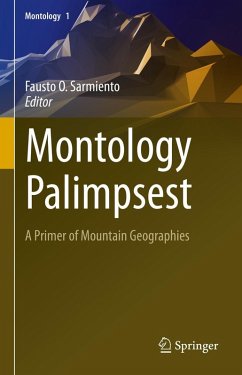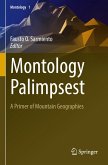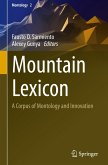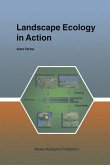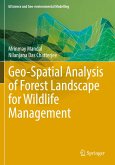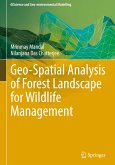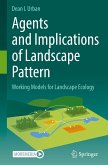Montology Palimpsest
A Primer of Mountain Geographies
Herausgegeben:Sarmiento, Fausto O.
Montology Palimpsest
A Primer of Mountain Geographies
Herausgegeben:Sarmiento, Fausto O.
- Gebundenes Buch
- Merkliste
- Auf die Merkliste
- Bewerten Bewerten
- Teilen
- Produkt teilen
- Produkterinnerung
- Produkterinnerung
This book introduces an innovative approach to sustainable and regenerative mountain development. Transdisciplinary to biophysical and biocultural scales, it provides answers to the "what, when, how, why, and where" that researchers question on mountains, including the most challenging: So What! Forwarding thinking in its treatment of core subjects, this decolonial, non-hegemonic volume inaugurates the Series with contributions of seasoned montologists, and invites the reader to an engaging excursion to ascend the rugged topography of paradigms, with the scaffolding hike of ambitious curiosity…mehr
Andere Kunden interessierten sich auch für
![Montology Palimpsest Montology Palimpsest]() Montology Palimpsest149,99 €
Montology Palimpsest149,99 €![Mountain Lexicon Mountain Lexicon]() Mountain Lexicon134,99 €
Mountain Lexicon134,99 €![Patch Dynamics Patch Dynamics]() Patch Dynamics39,99 €
Patch Dynamics39,99 €![Landscape Ecology in Action Landscape Ecology in Action]() A. FarinaLandscape Ecology in Action115,99 €
A. FarinaLandscape Ecology in Action115,99 €![Geo-Spatial Analysis of Forest Landscape for Wildlife Management Geo-Spatial Analysis of Forest Landscape for Wildlife Management]() Mrinmay MandalGeo-Spatial Analysis of Forest Landscape for Wildlife Management104,99 €
Mrinmay MandalGeo-Spatial Analysis of Forest Landscape for Wildlife Management104,99 €![Geo-Spatial Analysis of Forest Landscape for Wildlife Management Geo-Spatial Analysis of Forest Landscape for Wildlife Management]() Mrinmay MandalGeo-Spatial Analysis of Forest Landscape for Wildlife Management107,99 €
Mrinmay MandalGeo-Spatial Analysis of Forest Landscape for Wildlife Management107,99 €![Agents and Implications of Landscape Pattern Agents and Implications of Landscape Pattern]() Dean L UrbanAgents and Implications of Landscape Pattern75,99 €
Dean L UrbanAgents and Implications of Landscape Pattern75,99 €-
-
-
This book introduces an innovative approach to sustainable and regenerative mountain development. Transdisciplinary to biophysical and biocultural scales, it provides answers to the "what, when, how, why, and where" that researchers question on mountains, including the most challenging: So What! Forwarding thinking in its treatment of core subjects, this decolonial, non-hegemonic volume inaugurates the Series with contributions of seasoned montologists, and invites the reader to an engaging excursion to ascend the rugged topography of paradigms, with the scaffolding hike of ambitious curiosity typical of mountain explorers.
Chapter 8 is available open access under a Creative Commons Attribution 4.0 International License via link.springer.com.
Chapter 8 is available open access under a Creative Commons Attribution 4.0 International License via link.springer.com.
Produktdetails
- Produktdetails
- Montology 1
- Verlag: Springer / Springer International Publishing / Springer, Berlin
- Artikelnr. des Verlages: 978-3-031-13297-1
- 1st edition 2022
- Seitenzahl: 528
- Erscheinungstermin: 2. Januar 2023
- Englisch
- Abmessung: 241mm x 160mm x 34mm
- Gewicht: 951g
- ISBN-13: 9783031132971
- ISBN-10: 3031132971
- Artikelnr.: 64280470
- Herstellerkennzeichnung Die Herstellerinformationen sind derzeit nicht verfügbar.
- Montology 1
- Verlag: Springer / Springer International Publishing / Springer, Berlin
- Artikelnr. des Verlages: 978-3-031-13297-1
- 1st edition 2022
- Seitenzahl: 528
- Erscheinungstermin: 2. Januar 2023
- Englisch
- Abmessung: 241mm x 160mm x 34mm
- Gewicht: 951g
- ISBN-13: 9783031132971
- ISBN-10: 3031132971
- Artikelnr.: 64280470
- Herstellerkennzeichnung Die Herstellerinformationen sind derzeit nicht verfügbar.
Prof. Dr. Fausto O. Sarmiento has been involved in major disciplinary and institutional change processes to promote sustainable development in mountain environments and in restructuring evaluation criteria used for landscape conservation in the Tropical Andes. He was Regional Editor for Latin America for the journal Mountain Research and Development, and is Editorial Board member of Pirineos, the Journal of Mountain Ecology, the Journal of Mountain Science, the Journal of High Andean Research and the Annals of the AAG. He serves in advisory boards of global mountain organizations and represented the International Human Dimension Program of Global Environmental Change to the Science Board of the Mountain Research Initiative (MRI). He was chair of the Mountain Geography Specialty Group (2002-3 and 2014-5) of the Association of American Geographers (AAG), is chair of the International Geographical Union's Commission on Mountain Studies (IGU), and former president of the Andean Mountains Association (AMA). Currently, he is deputy Vice Chair (Capacity Building) of the Mountain Biome of the World Commission of Protected Areas (WCPA), member of the Board of the Satoyama Initiative of the United Nations University (UNU), member of the board of the Earth Ethics Institute (EEI) and member of the Protected Landscapes Task Force in the World Conservation Union (IUCN).
1. Introductory remarks.- Part 1: The Pioneering Dimension.- 2. Mountain Studies and Research in the Eighteenth Century: The Contributions of Horace Bénédict de Saussure and Alexander von Humboldt to the Study of Mountains.- 3. Mountain Development Adventure: The Hillary Model behind the Hillary Medal.- 4. Historical and Contemporary Contributions of the "Climber-Scientist" to Mountain Geography.- Part 2: The Human Dimension.- 5. Geopolitical and Cultural Appropriations: 'Mountain' as a Social Construct.- 6. Human Diversity, Identities, and Indigeneity in Contrasting Mountain Landscapes.- 7. Mountain Landscapes as "Lifescapes": Sustaining Traditional Biocultural Heritage and Supporting Resilience in the Asia-Pacific Region.- 8. Urbanization and the Verticality of Rural-Urban Linkages in Mountains.- Part 3: The Physical Dimension.- 9. Trends of Land Use and Land Cover Change in Mountain Regions.- 10. Atmospheric Envelopes and Glacial Retreat.- 11. Mountain Landslides - An Overview of Common Types and Future Impacts.- 12. The Spiritual and Cultural Importance of Mountains.- 13. A Biocultural Ethic for Coinhabiting Mountainous Rivers.- 14. High Altitude Archaeology and the Anthropology of Sacred Mountains: 25 Years of Explorations and Diseminations.- Part 5: The Biogeographical Dimension.- 15. The Paleoecological View from the Mountains.- 16. Mountain Waterscapes: Geographies of Interactions, Transformations and Meanings.- 17. Biogeography of Knowledges in the Mountainous Anthropocene: Hybrid Conceptual and Practical Spaces within the GeoHumanities.- 18. Agrobiodiversity in Mountain Territories: Family Farming and the Challenges of Social-Environmental Changes.- Part 6: The Conservation Dimension.- 19. Construction of Disaster Risk in Mountain Systems and its Integrated Management.- 20. Population Movements, Colonization Trends and Amenity Migrants in Mountainscapes.- 21. Mountain Protected Areas and Ecotourism for Sustainable Development: A Case Study of Ecuador.- 22. Mountain Biosphere Reserves as Model Territories: Reconciling the Goals of Biological/Cultural Heritage Conservation and Development.- 23. World Heritage and Mountain Sites.- Part 7: The Epistemological Dimension.- 24. Ecosystem Services and Benefits of Nature to People: Global Change Pressures and Conflicts of Use in Mountainscapes.- 25. Metascientific Approaches to Montology.- 26. Terminology and Argot Woes in the Corpus of Mountain Geographies.- 27. Conclusion.
1. Introductory remarks.- Part 1: The Pioneering Dimension.- 2. Mountain Studies and Research in the Eighteenth Century: The Contributions of Horace Bénédict de Saussure and Alexander von Humboldt to the Study of Mountains.- 3. Mountain Development Adventure: The Hillary Model behind the Hillary Medal.- 4. Historical and Contemporary Contributions of the "Climber-Scientist" to Mountain Geography.- Part 2: The Human Dimension.- 5. Geopolitical and Cultural Appropriations: 'Mountain' as a Social Construct.- 6. Human Diversity, Identities, and Indigeneity in Contrasting Mountain Landscapes.- 7. Mountain Landscapes as "Lifescapes": Sustaining Traditional Biocultural Heritage and Supporting Resilience in the Asia-Pacific Region.- 8. Urbanization and the Verticality of Rural-Urban Linkages in Mountains.- Part 3: The Physical Dimension.- 9. Trends of Land Use and Land Cover Change in Mountain Regions.- 10. Atmospheric Envelopes and Glacial Retreat.- 11. Mountain Landslides - An Overview of Common Types and Future Impacts.- 12. The Spiritual and Cultural Importance of Mountains.- 13. A Biocultural Ethic for Coinhabiting Mountainous Rivers.- 14. High Altitude Archaeology and the Anthropology of Sacred Mountains: 25 Years of Explorations and Diseminations.- Part 5: The Biogeographical Dimension.- 15. The Paleoecological View from the Mountains.- 16. Mountain Waterscapes: Geographies of Interactions, Transformations and Meanings.- 17. Biogeography of Knowledges in the Mountainous Anthropocene: Hybrid Conceptual and Practical Spaces within the GeoHumanities.- 18. Agrobiodiversity in Mountain Territories: Family Farming and the Challenges of Social-Environmental Changes.- Part 6: The Conservation Dimension.- 19. Construction of Disaster Risk in Mountain Systems and its Integrated Management.- 20. Population Movements, Colonization Trends and Amenity Migrants in Mountainscapes.- 21. Mountain Protected Areas and Ecotourism for Sustainable Development: A Case Study of Ecuador.- 22. Mountain Biosphere Reserves as Model Territories: Reconciling the Goals of Biological/Cultural Heritage Conservation and Development.- 23. World Heritage and Mountain Sites.- Part 7: The Epistemological Dimension.- 24. Ecosystem Services and Benefits of Nature to People: Global Change Pressures and Conflicts of Use in Mountainscapes.- 25. Metascientific Approaches to Montology.- 26. Terminology and Argot Woes in the Corpus of Mountain Geographies.- 27. Conclusion.

